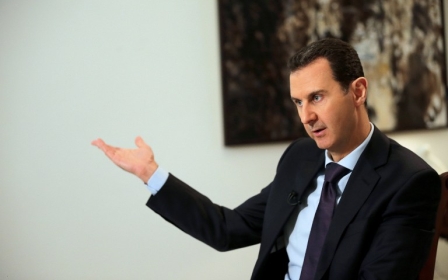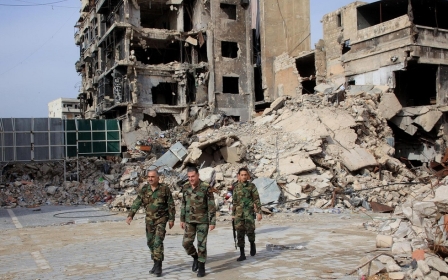Air strikes and fear drive thousands south from Daraa towards Jordan

AMMAN - Around 70,000 people are on the move in southern Syria, driven out of opposition-held towns and villages by an ongoing barrage of Russian air strikes on Daraa province.
The crisis along southern Syria’s agricultural belt is an eerie reflection of the disaster unravelling in northern Aleppo province, where tens of thousands of refugees, fleeing Russian air strikes, have piled up against a closed border gate. In both cases, the scale of displacement carries a note of caution: this is bad, but it could get so much worse.
The fear of what might happen were the scenario to further deteriorate may have contributed to Thursday night’s news that key international leaders had agreed to work towards establishing a ceasefire. But for those in the path of unrelenting air strikes, any respite will be too little, too late.
In southern Syria, humanitarians and residents say strikes have primarily targeted civilian infrastructure in opposition-held areas, destroying schools, homes and hospitals and leaving communities in tatters. Unlike the double-tap strikes and barrel bombs unleashed by the Syrian government, the Russian strikes come in long, highly destructive waves, say local activists in Daraa province who called the scale of destruction “unprecedented”.
While the refugees in the north can hope that Turkey will be persuaded to re-open its border gates and allow Syrians in, the southern refugees have no such illusions: Jordan, to the south, hasn’t admitted refugees along this stretch of border since 2013, and finding shelter in Israel, to the west, is unthinkable.
The devolution of security in Daraa province comes after years of heavy barrel bombings in opposition-held areas – now around 60 percent of the province, down from 65 percent just a month ago.
Russian sorties here began in September 2015 and increased sharply in late December, pummelling Sheikh Miskeen, a crossroads town north of Daraa city, with 500 air strikes over a month-long battle that yielded the government’s first significant gain in the south in more than a year.
By the time government loyalists captured Sheikh Miskeen, it was mostly destroyed and completely depopulated, but the win secured a government supply line to Daraa city and, perhaps more significantly, challenged the opposition’s long-held dominance in the province.
Psychological warfare
Thus far, the aerial campaign has focused on the rebel-held towns and cities east of Daraa city: in the past several weeks, between 80,000 to 100,000 people have fled the eastern part of the province for western towns of Ibtaa, Nawa and Dael. But this week, another large-scale displacement occurred as around 70,000 people from eastern and central Daraa began to move southwest, towards the Jordanian and Israeli borders, according to the UN High Commissioner for Refugees in Amman.
At least 10,000 of the most recently displaced are thought to be on the move northwards along Syria’s border with the occupied Golan Heights, to Quneitra, where the Islamic State-aligned Yarmouk Martyr’s Brigade holds sway.
The latest displacement has primarily been driven by air strikes: both people fleeing bombing as or after it happens, and people fleeing areas they fear will be targeted as the government’s campaign moves towards the province’s capital and the rebel-held cities along the international road that runs south to the border.
Humanitarian monitors say it has also been facilitated by what opposition activists call “psychological warfare” – the proliferation of false media reports about the government taking additional positions with the assistance of Russian bombing.
Divisions in opposition ranks are thought to be another driver, as morale drops and funds and supplies run low. Bashar Al Zoubi, leader of the Yarmouk Brigade, part of the Southern Front of the Free Syrian Army, said the increased demands on his men were unsustainable with current levels of support.
"The US, Saudi Arabia and Jordan haven't stopped their support, but they also haven't increased it in light of Russian and Iranian pressure,” he said.
The combination of heavy, sustained aerial bombing, deliberately confusing and distressing media reports, and rebel forces on the back foot has resulted in a large-scale movement of people, many of them already several times displaced.
'Boiling point'
While the Jordanian government doesn’t directly comment on developments in Syria, insiders said officials were spooked at the prospect of so many Syrians piling up along the western border. Unlike the desert wasteland of the eastern border, where a camp has been set up in the demilitarised zone on Jordan’s northern fringe and where border guards can easily contain security threats and control access to refugees, the western border is a populated belt of cities, towns and farmland.
Along the western border, displaced Syrians are staying in schools, abandoned houses and buildings, and local residents’ houses. A research group that closely monitors the situation in Daraa told MEE that in the town of Tal Shehab, local families are said to be hosting multiple displaced families in each household. At least 2,000 Syrians have reached the Nasib border crossing, which has been locked down since 2013, and several thousand more are in the nearby town of Zayzoun.
“The locals are taking them in by the dozen because it's freezing outside,” said one researcher.
For Jordan, the build-up of people on the country’s borders poses a security risk, and letting those people in is no longer an option: in the words of King Abdullah II, the country is “at boiling point” over the destabilising effects of around a million refugees.
"For the first time, we can't do it any more,” the Jordanian monarch told the BBC earlier this month.
Cross-border aid into Syria has dropped as security in Daraa has worsened, but the presence of so many displaced people so close to the border may make aid efforts easier – especially if a ceasefire can be negotiated.
“If it comes to fruition, we will pump massive amounts of NFIs [non-food items; humanitarian aid] and support into southern Syria,” said a high-level humanitarian source in Amman, speaking off the record.
But few are optimistic. In a statement on Friday, David Miliband, head of the NGO International Rescue Committee, which is active in Daraa province, called Syria “a war without law as well as a war without end”.
“We wait with eager anticipation to see whether this agreement is a turning point or a false dawn,” he said.
Stay informed with MEE's newsletters
Sign up to get the latest alerts, insights and analysis, starting with Turkey Unpacked
Middle East Eye delivers independent and unrivalled coverage and analysis of the Middle East, North Africa and beyond. To learn more about republishing this content and the associated fees, please fill out this form. More about MEE can be found here.




